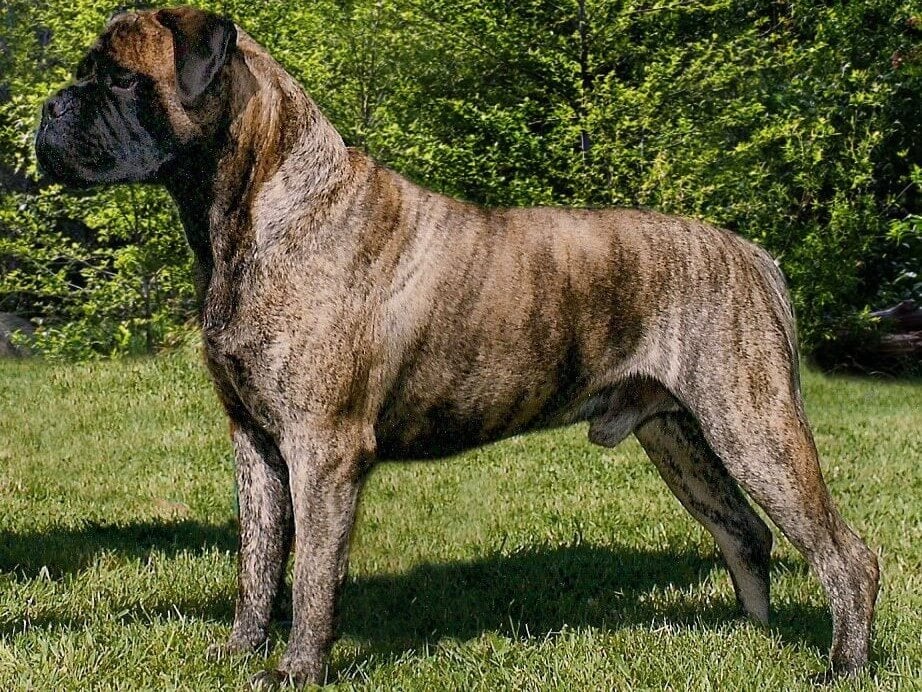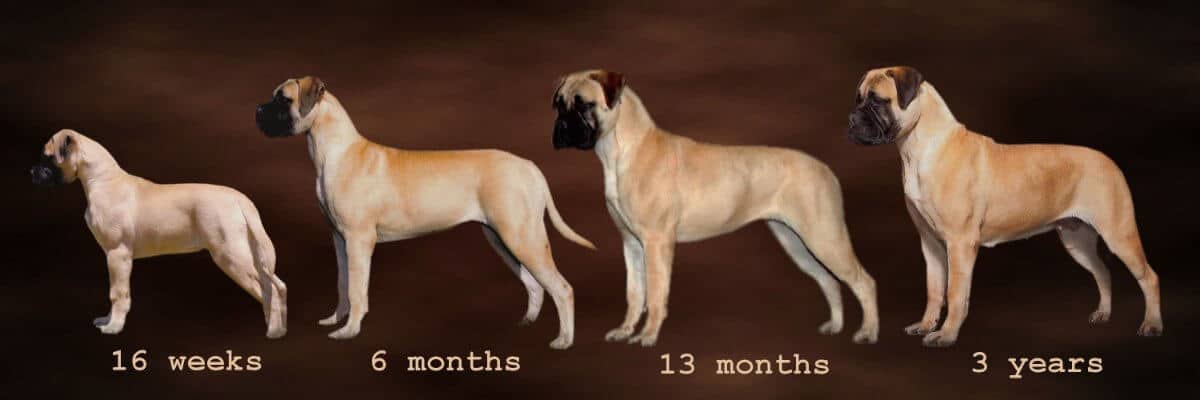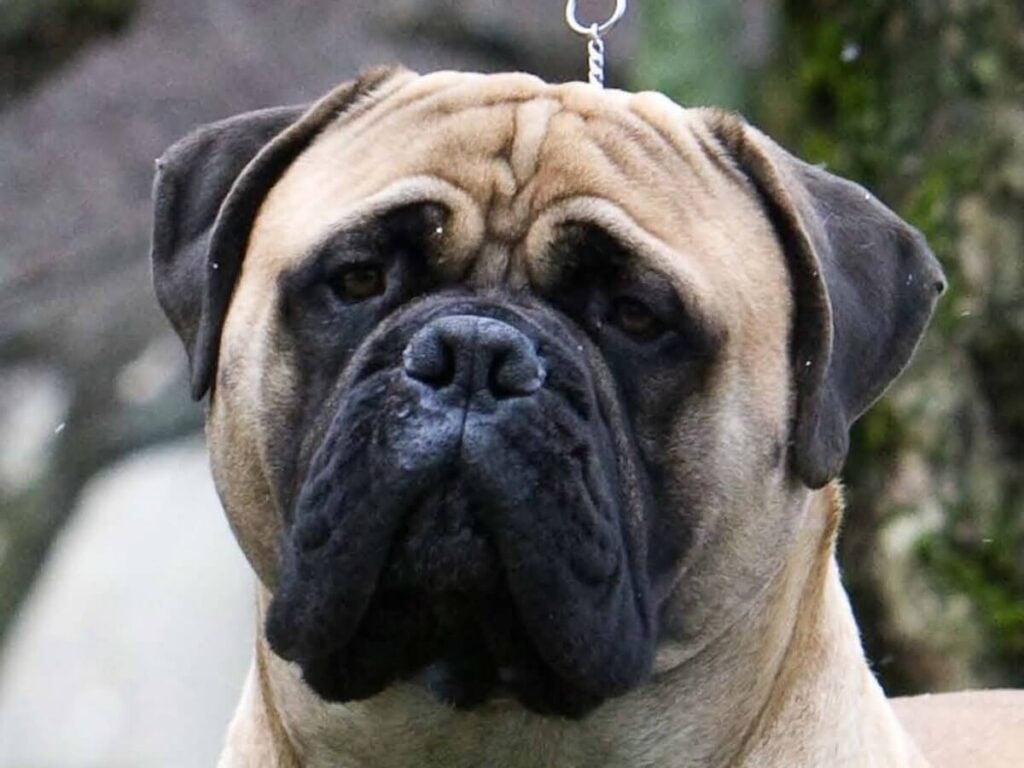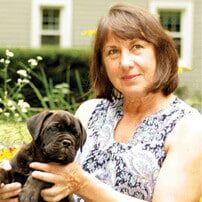
Home » Judging the Bullmastiff

This article was originally published in Showsight Magazine, November 2016 issue.
Imagine nineteenth-century England before industrialization. Picture a rural, agrarian society composed of large feudal estates surrounded by small tenant farms. Think of the gamekeeper, whose duty was to prevent the desperate and determined poacher from illegally taking the wild game that roamed the landowner’s property. And envision a large, powerful and agile dog, as dark as night, with the ability to sneak up on the poacher unaware, knock him to the ground, and hold him without harm until the gamekeeper arrived the next morning. This “gamekeeper’s night dog,” fearless yet not ferocious, was the predecessor of today’s Bullmastiff.
Twenty-first-century America bears little resemblance to the English countryside of two centuries ago. The Bullmastiff, which arrived in the US during the first half of the twentieth century, has adapted easily to his new environment and duties. Without an estate to roam and protect, the Bullmastiff has evolved into a reliable family guardian and pet. Yet he retains the courage, intelligence, discrimination, as well as the independent spirit, of his formidable ancestors.

Walking into the Bullmastiff specials ring should be an impressive sight, your first sense of the breed as a symmetrical nearly-square dog, showing great strength, endurance, and alertness; powerfully built and active. They are a working breed and should be sound structurally and moving in all directions, balanced front to rear, with heavy hindquarters, depth of body with pro sternum and good bone-to-body proportion. Silhouette is the first thing we see when looking over the lineup, and along with correct head type (cube on cube), soundness moving and structurally, temperament and health, all should be included in your order of priority. The physical examination of the breed should not be unlike any other working breed. “What you see, is what you get” and a cursory hands-on examination is sufficient. However, don’t stoop down in front to examine the head or stare at a Bullmastiff. No need to check for full dentition, and a perfunctory look at the bite will suffice. Grossly undershot, overshot and wry bites are serious faults but can be easily observed in your quick mouth exam. Discourage any barking in your ring, as this could incite aggressive behavior in your entry and don’t overcrowd the ring, allow sufficient space between entries, particularly between dogs. Bullmastiffs are generally well behaved and even the owner handler has a capable hand when showing this breed. The breed is usually friendly with wagging tails and overzealous puppy behavior. They can be guarded with strangers, but should never lack confidence or shy away from the judge, or not recover quickly if startled by loud noises.
But what makes the Bullmastiff a less popular choice in the Working Group or Best in Show ring? Not a ‘sexy’ breed, the Bullmastiff might be less understood and not as flashy as other dogs in the final lineup. As a serious working breed, although their silhouette would suggest a “look of eagles” their gait is not and should not be flashy but rather a more powerful, deliberate breed-appropriate gait, not tremendous reach and drive. With their breed-appropriate side gait, many lack the showy attitude of other working breeds and with correct head type might be less commonly understood, which in turn can shake a judge’s confidence in awarding the prestigious honor. A rectangular Bullmastiff, with heavy pigment and a level bite does not make a great Bullmastiff, only a generic dog. Perhaps these dogs may achieve their championship, but they should not be winning groups and bests in show! While we applaud judges that reward soundness, it should not come at the expense of incorrect body proportion, length of back, or head type. Many judges also seem to focus on cosmetic flaws rather than structure, which includes correct nearly square proportion, proper shoulder layback (difficult to find in this breed) and moderate front and rear angulation, as well, of course, correct head type.
Type is misunderstood, and we can have a variety of types in the ring, which include Bullmastiffs that look like Mastiffs (too big, too much flew), Shar-Pei (too heavily wrinkled), Rhodesian Ridgebacks (too refined and snipey), Staffy Bulls (short) and Dogue de Bordeaux (round heads, incorrect topline, red color and coat texture). Bullmastiffs are a compact, deep, square dog. A long, rectangular Bullmastiff is incorrect.
From the Bullmastiff Standard: “That of a symmetrical animal, showing great strength, endurance, and alertness; powerfully built but active. “Body should be compact. Back—short, giving the impression of a well-balanced dog. “Proportion — The length from tip of breastbone to rear of thigh exceeds the height from withers to ground only slightly, resulting in a nearly square appearance.” These are some of the most important words defining type in the Bullmastiff Standard. The “general appearance” in our standard gives one a good sense of Bullmastiff type – “symmetrical (nearly square/balanced), great strength (sound), powerfully built (substantial).” But if any Bullmastiff sticks his head through a hole in the fence, would you absolutely identify it as a Bullmastiff? If you don’t, it is the most serious fault of all. If there is a Mastiff and Bullmastiff standing on a hillside in the distance, one is rectangular the other square, which is the Bullmastiff? If a Bullmastiff needs to look like a Bullmastiff, it must be nearly square. You need to read and study the standard and engage in other means of education to best understand Bullmastiff breed type.

The most frequently mentioned concept in the Bullmastiff standard has to do with proportion. The standard alternatively refers to the Bullmastiff as “symmetrical,” “nearly square,” “compact,” “short” backed, and “well balanced.” This suggests that an essential Bullmastiff characteristic is a nearly square appearance. It is important to keep in mind that it is not only size, but also proportion that distinguishes the Bullmastiff from the larger and longer Mastiff. In profile, and from all angles, the Bullmastiff should appear square. Thus when considering the Bullmastiff, an important point to remember is that long is always wrong. Nearly square proportion every bit defines breed type as the squareness of the head and muzzle. Proportion and size is what defines the difference between a Mastiff and Bullmastiff.
The concept of squareness also applies when considering the Bullmastiff head. In the Bullmastiff ring, you will undoubtedly find a variety of head types as the liberal Bullmastiff standard allows for a range of interpretation. However, it is important to remember that each individual element that comes together in the Bullmastiff headpiece should contribute to its square appearance. This not only applies to traits such as the broad, deep muzzle and the large skull with well-developed cheeks, which Bullmastiff breeders often refer to as a “cube on a cube,” but also to such characteristics as ear set, shape, and size, the width of the underjaw, and eye shape and placement. Rather than think of each of these attributes separately, base your assessment on the degree to which they contribute to the nearly square appearance of the Bullmastiff head.
The head and muzzle should be square. Muzzle should be broad and deep, ears small and v-shaped, level with the occiput, cheeks should be well developed, flews not too pendulous, all helping to create a square appearance to the head. The reversion to the Bulldog is very undesirable. If a head reminds you of a Mastiff, Bulldog, Rhodesian Ridgeback, Am Staff or Shar Pei it is very incorrect. Round and wrinkly skulls, too much wrinkle/roping on the muzzle, drooping flews, too severe a stop (Bulldog like) are not correct in a Bullmastiff, any more than a long, narrow muzzle or a lack of stop.

In judging the Bullmastiff we see varying degrees of bites, but mainly good bites with wide underjaws and straight teeth. The evolution of the breed to a less moderate and more ‘bully’ appearance has led to the reversion to the more Bulldog type of bite and underjaw, which is incorrect, however the perfect bite can and should be accomplished in the best of heads.
“When viewed from the side, reach and drive indicate maximum use of the dog’s moderate angulation. Back remains level and firm. Coming and going, the dog moves in a straight line.” The down and back should be closely observed for many structural faults not obvious on the go-around. We need to slow them down in the show ring. Bullmastiffs are not herding dogs, and their side gait should reflect use of moderate angles. Cow hocks and splayed feet are the only serious faults mentioned in our standard and should be penalized appropriately. Bullmastiffs should not be giant Bulldogs or Mastiffs, nor should they move like either of these breeds. Bullmastiffs should be sound coming and going, and have moderate reach and drive to accomplish a smooth, even gait. Their gait should be powerful and deliberate. “Flashy” movement is not what is appropriate for this breed and showmanship should never override breed correctness. When evaluating breeding stock, either as a judge or a breeder, the first thing we look at is static balance in the silhouette. Unlike breeds whose bodies are longer than tall, a square dog must be built to the correct proportions and angles if it is to move correctly. We do not look at a dog’s gait in a search for beauty and flash but rather as evidence that the dog is both fit and functional for the job it was bred for. In observing how a dog moves, one evaluates the dog as a whole trying to assess the ability of the dog to do its historic work … and if accurate, it is usually associated with correctly constructed and athletically fit dogs.
The most efficient working dogs are those that can work the longest at their jobs with the least amount of effort. The efficiently moving Bullmastiff travels in a straight line with the minimum amount of energy, legs converging under the body as speed increases. Length of stride of the dog is an important consideration. For any breed of dog, the fewer steps required to cover a given distance, the less energy is required. With the Bullmastiff’s moderate angles and compact body, the motion should be deliberate and powerful, but not fast. A Bullmastiff is a working dog that patrolled huge estates all night, hundreds of acres, not small courtyards, so tight feet, proper moderate angulation, well let down strong hocks, firm backs, sound shoulders and heavy hindquarters were as important as the instinct to guard.
Appropriately compact Bullmastiffs are more capable of quick and sudden movement and can better make sudden change in speed and direction and maintain balance and grace than a long dog. This form following function is closely related to body type and the job the Bullmastiff was bred to do: to be able to penetrate thickets and dense underbrush, to be agile to maneuver around, over and under various obstacles, with the ability to move swiftly and gingerly. A dog can be moving in the show ring with less style than its competitors but be moving correctly. The first structural issue is the very important requirement that the Bullmastiff is nearly square, the squareness which defines breed type.
Please do not reward a Bullmastiff with its tail between its legs. To quote Richard Beauchamp from his book, Solving the Mysteries of Breed Type, “Everything in the Bullmastiff standard assures us of a dog that will stand its ground and protect at all costs. Stalwart but effectively mobile, the antithesis of what we look for in the lightning-rod sighthounds. A Bullmastiff’s stance and attitude tell us exactly what we need to know about the Bullmastiff in this respect.”
Temperament is the quintessential barometer of breed type: “Fearless and confident yet docile. The dog combines the reliability, intelligence, and willingness to please required in a dependable family companion and protector.” Too often we see Bullmastiffs with tails between their legs. This attitude should not be rewarded. Bullmastiffs should be stable, confident, bold and courageous. They should be a discerning guard dog and know the difference between an intruder and the UPS man. Aggressive behavior toward any person should never be tolerated in the show ring. Aggressive behavior toward other dogs is not the same as aggression toward people and should only be penalized if out of control. A Bullmastiff with its tail between its legs is afraid, whether or not temporary, it should not be rewarded in the show ring on that day. Please do not confuse a gay tail with attitude. “Set on high. It may be straight or curved, but never carried hound fashion.” A tail carried over the back is very incorrect.
Bullmastiffs should have good coats providing them adequate protection against the weather elements and the ground cover. A double coat is ideal, but the coat should be short and dense. Healthy coats with skin free of allergies are ideal for their work and environment. Good condition is a sign of good health, and after all, we are judging breeding stock. Entropic eyes, missing hair, interdigital cysts, thin coats, narrow, restricted nostrils, fat dogs or dogs lacking in muscle development are all signs of poor condition and/or health problems.
“Other things being equal, the more substantial dog within these limits is favored.” The reason for this statement should be clear — a more substantial dog is better equipped to pin and hold the poacher. This is form following function. This does not mean “bigger is better.” That being said, because the male is more opulent than a female, avoid gender discrimination as an otherwise beautiful bitch should not be rewarded because she is smaller than the male … bitches ARE smaller than males. Some Bullmastiff bitches are petite. If we adhere to form following function, a petite bitch could not knock a man down and hold him. Bitches should proportionately have good bone and substance as their male counterparts (bitches 24-26″, 100-120 pounds). Although there may be a place in a breeding program for a sound, typey small bitch, a truly petite bitch should not be rewarded in the show ring
As a night dog, brindle certainly would have been the preferred color as camouflage while at work. However, there is no color preference in the Bullmastiff. Unfortunately the brindle color seems to be discriminated in the show ring, perhaps because of an optical illusion, or lack of attention to detail. Brindling should ideally be evenly distributed. Red color ranges from honey to dark mahogany. The “orange” Dogue de Bordeaux color in incorrect, as is the “brown” color we also see. The coat should be clear, free from smuttiness with two-toning undesirable. A small white patch on the chest is acceptable, but white anywhere else on the body is very undesirable. A dark muzzle is preferred, but obviously breeders like to see the blacker the better. I personally like to see a slight break under and between the eyes, to emphasize the “mask.” Be wary of how pigment can change the overall look of the head and rely on manual exam to conclude on correct bone structure of the muzzle not visual. And that while a full black mask may be striking, there will always be a natural blending between body color and the mask/muzzle and start of the ear color. Be suspect of masks that appear dyed or artificial.
There is frequent discussion regarding dogs defined as either “breed” or “group” dogs. Theoretically, if you have a quality dog, there should be no difference. Nevertheless, we hear it all the time: “He’s more a group dog” or “He can win in the breed, but he can’t compete in the group.” Why is this? There are many factors going into the decision of a judge at the breed and group level. As a judge of Bullmastiffs and the working group, knowing the nuances of the breed and understanding breed type, it would make no difference as long as it is a quality dog. One is judging at the group level against the breed standards, not against each other. If you have a healthy nearly-square Bullmastiff, typey, sound with a good attitude and sound movement, it is indeed competitive in the group ring. Bullmastiffs seem to need to work harder for their recognition in the group.
